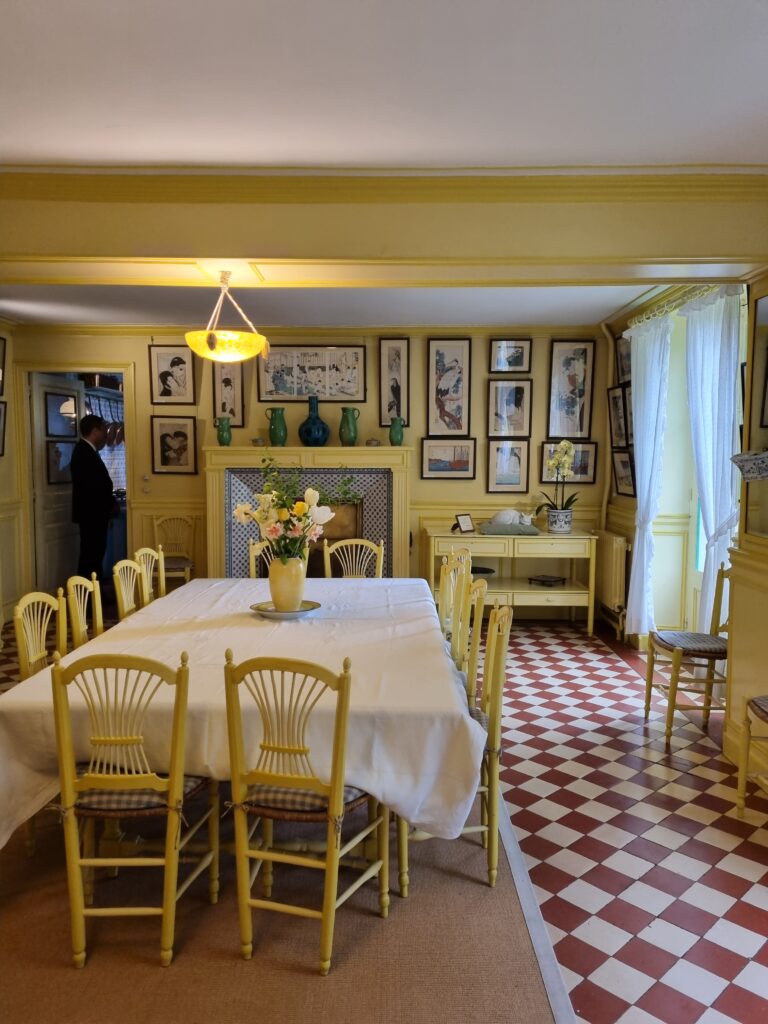The garden of Claude Monet’s residence in Giverny, portrayed several times in his canvases, with its famous water lilies bordering on abstraction and its green Japanese bridge, was designed by the impressionist painter as a work of art.
When the painter Claude Monet (1840-1926) moved to a place called Le Pressoir, in a rental house in the village of Giverny, in Eure, with his partner Alice Hoschedé, they had respectively two children for one (Monet’s first wife , Camille, died) and six children to each other (Alice is still married).
It was by taking the small railway line that connects Gasny to Vernon and that passes in front of the property’s vegetable garden and orchard, along the Chemin du Roy, that Monet allowed himself to be seduced, to paint it, by the landscape of hills and the banks of the river. Sena in this corner of the Norman Vexin.
It’s 1883, and if his Impression, Rising Sun was sold – to the photographer Nadar – in 1874, the 43-year-old painter still hasn’t really experienced success. He ordered, however, to enlarge the studio, at the back of the house, when he declared: “I don’t need a studio.
My atelie is outdoors. In fact, he reworks his canvases indoors, painted on the motif, in search of an unattainable finish, while he dedicates himself to his garden, his other great work (he loves flowers above all), which he wants to color throughout the year. “The garden is his studio”, says Alice. There you have it, your palette! »
The former pressoir without charm transformed into a “maison de maître” by its previous owner is becoming, thanks to the additions and modifications of its new occupants, a pleasant “maison des champs” –
Monet would acquire the house in 1890, thanks to an advance of his dealer, Paul Durand-Ruel, before astute American collectors gathered in their haystacks and … sustainably enriched the Impressionist artist. The kitchen, in particular, is the object of all attention: the owner of the place, whose fat girls reveal their appetite and taste for good food, had it covered with blue and white faience tiles from Rouen, of the most beautiful effect.
Transform again and again
The black cast iron stove and the imposing polished copper pots stand out, next to the dining room with its bright yellow painted walls, with its Japanese prints of Utamaro, Hokusai or Hiroshige. The large “blended” family of the artist and his wife (they were married in 1892, after the death of Alice’s husband) often share a table with very close friends (friends, not “guests”). which Monet deliberately kept at a distance). This inner circle includes the painters Gustave Caillebotte and Berthe Morisot, the writer Octave Mirbeau or the critic Gustave Geffroy and of course Georges Clemenceau, the lifelong friend.

It was Monet himself who kept the original pink plaster for the outer walls and chose green for the doors and shutters. His bedroom, located upstairs above the workshop-living room, amply lit by three large windows overlooking the garden, is furnished with a desk and an 18th-century chest of drawers. Hanging on the walls and around the bed, many works by his painter friends: Renoir, Manet, Degas, Pissarro, Sisley, or by admired artists: Boudin, Corot, Delacroix… (These are examples that can currently be seen in the house and the studio, the originals being kept at the Musée Marmottan-Monet, in Paris, or at the Museum of Modern Art in New York.)
In Giverny, during the decades that he lived there and where he painted there, until his death in 1926, Monet did not stop transforming and developing his two gardens: the first, the Clos Norman, adjacent to the house, mostly flowering, and the second , Jardim das Águas, located on the other side of the road, and whose land, originally susceptible to flooding, was acquired in 1893. Its development was not without difficulties: it was necessary to divert the Ru, a tributary of the ‘Epte, the Câmara Municipality, however, fearing that “exotic plants”… might poison the water.
Monet gradually loses his eyesight
Before Clos Normand, Monet maintained other gardens, including Argenteuil, where Renoir painted it… painting (1873), gardening by Manet (La Famille Monet dans son jardin, 1874), and which he himself represented, extremely flowery. Flowers are essential to him – minus boxwood or spruce and cypress, which he will replace at Giverny with metal arches on which rosebushes will climb. The nasturtium crawling in the central aisle is one of his lucky finds. In the flowerbeds and on the trellises or stakes, flowers, carefully prepared, follow one another throughout the year: crocuses and snowdrops, tulips, yellow or blue lilies, dahlias and poppies in extravagant autumn colours.
The development of Jardin d’Eau, with the excavation of a sinuous basin whose design was repeated several times, would occupy thirty years of the painter’s life.
The iconic green bridge, partially hidden by weeping willows and topped by a fragrant white and lilac wisteria that disintegrates into metal arches, will be directly inspired by the world of Japanese prints. Likewise, plantings of tall bamboo, maple, peony or hydrangea around the water body. Another innovation promised to posterity: the arrangement of white, pink or blue water lilies in the basin, discovered by Monet with admiration during the Universal Exhibition of 1889.
Monet would not stop painting them ever since, until the almost abstraction of the last large formats, created from 1915 onwards in the new atelier devoted to this purpose – large formats that can be admired at the Musée de l’Orangerie, in Paris.
Meanwhile, still monopolized by his horticultural passion, the painter-gardener ordered the installation of climate-controlled greenhouses where he could produce seedlings and protect his most fragile plants from frost. Gradually losing his sight, Monet died in Giverny on December 5, 1926, aged 86, from lung cancer. Sacha Guitry, who in 1915 had the privilege of filming him painting for a few moments, later recounted that Clemenceau would have replaced the shroud that would cover the coffin with a flowery curtain… torn from a window: “No black for Monet! he would have exclaimed.
After the painter’s death, it was his daughter-in-law, Blanche Hoschedé-Monet, who took care of the property until his death in 1947. In 1966, the house and garden, in very poor condition, were finally ceded by Michel Monet, son of Claude, to the Academy of Fine Arts. In 1977, she entrusted her management and restoration projects to Gérald Van der Kemp, who was for almost thirty years the chief curator of Versailles, who benefited, with the support of his wife, Florence , from his experience.
The choice was relevant, and the couple’s impressive schedule did wonders to attract sponsorship, mainly American, and know-how to Giverny. Starting with the team of gardeners, which will be managed for more than forty years by the affectionate head gardener Gilbert Vahé.
Thus, until they opened to the public on June 3, 1980, the gardens were able to regain the appearance they had in Monet’s time, namely thanks to restorations based on all available documents and testimonies.
These include period photographs, including the splendid and famous autochromies of the 1920s, descriptions of the painter’s relatives or visitors, artists or writers. And above all thanks to Monet’s own order forms for flowers or plants, which are always inspired by gardeners – placed under the authority of the current director of the foundation, Hugues Gall – to compose the spectacular flower beds of the Clos Norman or the so poetic vegetable atmospheres of the Water Garden.

